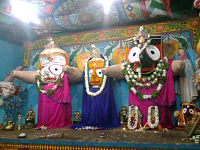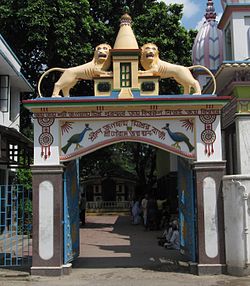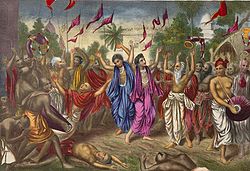- Chaitanya Mahaprabhu
-
Chaitanya Mahaprabhu (also transliterated Caitanya, IAST caitanya mahāprabhu) (Bengali: চৈতন্য মহাপ্রভু, Oriya: ଚୈତନ୍ୟ ମହାପ୍ରଭୁ) (1486–1534) was a Vaishnava saint and social reformer in eastern India (specifically present-day Bangladesh and states of West Bengal, Bihar, Jharkhand, Manipur, Assam, and Orissa of India) in the 16th century,[1] believed by followers of Gaudiya Vaishnavism to be the full incarnation of Lord Krishna.[2] Sri Krishna Chaitanya was a notable proponent for the Vaishnava school of Bhakti yoga (meaning loving devotion to Krishna/God) based on the philosophy of the Bhagavata Purana and Bhagavad Gita.[3] Specifically he worshipped the forms of Radha and Krishna and popularised the chanting of the Hare Krishna maha mantra[4] and has composed Siksastakam in Sanskrit. His line of followers, known as Gaudiya Vaishnavas, revere him as an Avatar of Krishna in the mood of Radharani who was prophesised to appear in the later verses of the Bhagavata Purana.[5]
He was also sometimes referred to by the names Gaura (Sanskrit for golden one) due to his light skin complexion,[6] and Nimai due to his being born underneath a Neem tree.[7] There are numerous biographies available from the time giving details of Chaitanya's life, the most prominent ones being the Chaitanya Charitamrita of Krishnadasa Kaviraja Goswami and the earlier Chaitanya Bhagavata of Vrindavana Dasa[8] (both originally written in Bangla but now widely available in English and other languages) and the Chaitanya Mangala, written by Lochana Dasa.[9]
Contents
Sri Chaitanya's life
According to the biography, Chaitanya Charitamrita, Nimäi appeared on the full moon night of February 18, 1486, at the time of a lunar eclipse.[10] His parents named him 'Vishvambhar'. Sri Chaitanya was the second son of Jagannath Mishra and his wife Sachi Devi who lived in the town of Nabadwip in Nadia, West Bengal.[11][12]
In his youth, Chaitanya Mahäprabhu was primarily known as an erudite scholar, whose learning and skills in argumentation in his locality were second to none. A number of stories also exist telling of Chaitanya's apparent attraction to the chanting and singing of Krishna's names from a very young age,[13] but largely this was perceived as being secondary to his interest in acquiring knowledge and studying Sanskrit. When traveling to Gaya to perform the shraddha ceremony for his departed father Chaitanya met his guru, the ascetic Ishvara Puri, from whom he received initiation with the Gopala Krishna mantra. This meeting was to mark a significant change in Mahäprabhu's outlook[14] and upon his return to Bengal the local Vaishnavas, headed by Advaita Ächärya, were stunned at his external sudden 'change of heart' (from 'scholar' to 'devotee') and soon Chaitanya became the eminent leader of their Vaishnava group within Nadia.
After leaving Bengal and receiving entrance into the sannyasa order by Keshava Bharati,[15] Chaitanya journeyed throughout the length and breadth of India for several years, chanting the divine Names of Krishna constantly. He spent the last 24 years of his life in Puri, Orissa,[16] the great temple city of Jagannäth. The Suryavanshi Hindu emperor of Orissa, Gajapati Maharaja Prataparudra Dev, regarded the Lord as Krishna's incarnation and was an enthusiastic patron and devotee of Chaitanya's sankeertan party.[17] It was during these years that Lord Chaitanya is believed by His followers to have sank deep into various Divine-Love (samādhi) and performed pastimes of divine ecstasy (bhakti).[18]
Identity
This is an interactive (clickable) image-map. Click on lotus feet. Sri Krishna Chaitanya (centre), Sri Nityananda Prabhu (wearing blue), Sri Advaita Acharya (with beard), Sri Gadadhara Pandit (purple dhoti), Sri Srivas Pandit (with shaven head and saffron dhoti). Pancha-Tattva deities: Chaitanya Mahaprabhu, Nityananda, Advaita Acharya, Gadadhara and Srivasa, installed on a Vaishnava altar.
According to beliefs of orthodox followers Caitanya Mahaprabhu united in himself two aspects: ecstatic devotee of Krishna and Krishna himself in inseparable union with Radha. According to the hagiographies of 16th c. authors he has exhibited his Universal Form identical to that of Krishna on a number of occasions, notably to Advaita Ācārya and Nityānanda Prabhu.[19][20][21]
Teachings
Chaitanya has left one written record in Sanskrit called Siksastakam.
Chaitanya's epistemological, theological and ontological teachings are summarized as ten roots or maxims dasa mula:[22]
- The statements of amnaya (scripture) are the chief proof. By these statements the following nine topics are taught.
- Krishna is the Supreme Absolute Truth.
- Krishna is endowed with all energies.
- Krishna is the ocean of rasa (theology).
- The jivas (individual souls) are all separated parts of the Lord.
- In bound state the jivas are under the influence of matter, due to their tatastha nature.
- In the liberated state the jivas are free from the influence of matter, due to their tatastha nature.
- The jivas and the material world are both different from and identical to the Lord.
- Pure devotion is the practice of the jivas.
- Pure love of Krishna is the ultimate goal.
- Krishna is the only lovable blessing to be received.
Chaitanya's tradition
 Deities of Chaitanya Mahaprabhu (right) and Nityananda (left) at Radha-Krishna temple in Radhadesh, Belgium
Deities of Chaitanya Mahaprabhu (right) and Nityananda (left) at Radha-Krishna temple in Radhadesh, Belgium
Despite having been initiated in the Madhvacharya tradition and taking sannyasa from Shankara's tradition, Chaitanya's philosophy is sometimes regarded as a tradition of his own within the Vaishnava framework - having some marked differences with the practices and the theology of other followers of Madhvacharya. He took Mantra Upadesa from (Isvara Puri) and Sanyasa Diksha from Kesava Bharathi. Both these gurus are of Sankarite order of Advaita.
Chaitanya Mahaprabhu is not known to have written anything himself except for a series of verses known as the Siksastaka, or "eight verses of instruction",[23] which he had spoken, and were recorded by one of his close colleagues. The eight verses created by Mahaprabhu are considered to contain the complete philosophy of Gaudiya Vaishnavism in condensed form. Chaitanya requested a select few among his followers (who later came to be known as the Six Gosvamis of Vrindavan) to systematically present the theology of bhakti he had taught to them in their own writings.[24] The six saints and theologians were Rupa Goswami, Sanatana Goswami, Gopala Bhatta Goswami, Raghunatha Bhatta Goswami, Raghunatha dasa Goswami and Jiva Goswami, a nephew of brothers Rupa and Sanatana. These individuals were responsible for systematizing Gaudiya Vaishnava theology.
Narottama Dasa Thakur, Srinivasa Acarya and Syamananda Pandit were among the stalwarts of the second generation of Gaudiya Vaishnavism. Having studied under Jiva Goswami, they were instrumental in propagating the teachings of the Goswamis throughout Bengal, Orissa and other regions of Eastern India. Many among their associates, such as Ramacandra Kaviraja and Ganga Narayan Chakravarti, were also eminent teachers in their own right.[25]
The festival of Kheturi, presided over by Jahnava Thakurani,[26] the wife of Nityananda Prabhu, was the first time the leaders of the various branches of Chaitanya's followers assembled together. Through such festivals, members of the loosely organized tradition became acquainted with other branches along with their respective theological and practical nuances.[27] Around these times, the disciples and descendants of Nityananda and Advaita Acharya, headed by Virabhadra and Krishna Mishra respectively, started their family lineages (vamsa) to maintain the tradition. The vamsa descending from Nityananda through his son Virabhadra forms the most prominent branch of the modern Gaudiya tradition, though descendants of Advaita, along with the descendants of many other associates of Chaitanya, maintain their following especially in the rural areas of Bengal. Gopala Guru Goswami, a young associate of Chaitanya and a follower of Vakresvara Pandit, founded another branch based in Orissa. The writings of Gopala, along with those of his disciple Dhyanacandra Goswami, have had a substantial influence on the methods of internal worship in the tradition.
From the very beginning of Chaitanya's bhakti movement in Bengal, Haridasa Thakur and others Muslim or Hindu by birth were the participants. This openness received a boost from Bhaktivinoda Thakura's broad-minded vision in the late 19th century and was institutionalized by Bhaktisiddhanta Sarasvati in his Gaudiya Matha in the 20th century.[28] In the 20th century the teachings of Chaitanya were brought to the West by A.C. Bhaktivedanta Swami Prabhupada, a representative of Bhaktisiddhanta Sarasvati Thakura branch of Chaitanya's tradition. Bhaktivedanta Swami founded his movement known as The International Society for Krishna Consciousness (ISKCON) to spread Chaitanya's teachings throughout the world.[29] Saraswata gurus and acharyas, members of the Goswami lineages and several other Hindu sects which revere Chaitanya Mahaprabhu, including devotees from the major Vaishnava holy places in Mathura District, West Bengal and Orissa, also established temples dedicated to Krishna and Chaitanya outside India in the closing decades of the 20th century. In the 21st century Vaishnava bhakti is now also being studied through the academic medium of Krishnology in a number of academic institutions.[30]
Cultural legacy
In addition to his deep influences on Hinduism, Chaitanya's cultural legacy in Bengal and Orissa remains deep, with many residents performing daily worship to him as an avatar of Krishna. Some attribute to him a Renaissance in Bengal,[31] different from the more well known 19th century Bengal Renaissance. Salimullah Khan, a noted linguist, maintains, "Sixteenth century is the time of Chaitanya Dev, and it is the beginning of Modernism in Bengal. The concept of 'humanity' that came into fruition is contemporaneous with that of Europe".
See also
Footnotes
- ^ Britannica: Caitanya Movement
- ^ Ravi Shankar discusses Sri Chaitanya Mahaprabhu
- ^ Srimad Bhagavatam (Introduction) "Lord Caitanya not only preached the Srimad-Bhagavatam but propagated the teachings of the Bhagavad-gita as well in the most practical way"
- ^ Sri Chaitanya Mahaprabhu "He spread the Yuga-dharma, or the practice most recommended for the attainment of pure love for Sri Sri Radha-Krishna. That process is Harinam Sankirtan, or the congregational chanting of the Holy Names of the Lord: Hare Krishna Hare Krishna Krishna Krishna Hare Hare, Hare Rama Hare Rama Rama Rama Hare Hare"
- ^ Bhag-P 11.5.32 "In the age of Kali, intelligent persons perform congregational chanting to worship the incarnation of Godhead who constantly sings the names of Krishna. Although His complexion is not blackish, He is Krishna Himself. He is accompanied by His associates, servants, weapons and confidential companions."
- ^ In the Name of the Lord (Deccan Herald) "He was also given the name of ‘Gaura’ (meaning golden) because of his extremely fair complexion."
- ^ KCM Archive "they named Him, Nimai, as he was born under a neem tree"
- ^ Gaudiya Literature
- ^ Biography of Sri Locana Dasa Thakura (salagram.net)
- ^ Sri Caitanya Mahaprabhu: His Life and Precepts, by Bhaktivinoda Thakura "Caitanya Mahäprabhu appeared in Nabadwip in Bengal just after sunset on the evening of the 23rd Phälguna 1407 Shakabda, answering to 18 February 1486, of the Christian Era. The moon was eclipsed at the time of His 'birth'"
- ^ Sri Caitanya Mahaprabhu: His Life and Precepts, by Bhaktivinoda Thakura
- ^ Nair, p. 87
- ^ CC Adi lila 14.22
- ^ CC Adi lila 17.9 "In Gayla, Sri Chaitanya Mähaprabhu was initiated by Isvara Puri, and immediately afterwards He exhibited signs of love of Godhead. He again displayed such symptoms after returning home."
- ^ Teachings of Lord Chaitanya "They were surprised to see Lord Chaitanya after He accepted his sannyasa order from Kesava Bharati"
- ^ History of Gaudiya Vaishnavism "Chaitanya spent the remainder of His life, another 24 years, in Jagannäth Puri in the company of some of His intimate associates, such as Svarüpa Dämodara and Rämänanda Räya"
- ^ Gaudiya Vaishnavas "His magnetism attracted men of great learning such as Särvabhauma Bhattächärya, the greatest authority on logic, and Shree Advaita Ächärya, leader of the Vaishnavas in Bengal, and men of power and wealth like the King of Orissa, Pratapa Rudra and his brähman minister, Rämänanda Räya..."
- ^ Srimad Bhagavatam, Introduction "At Puridhawm, when he [Chaitanya] entered the temple of Jagannätha, he became at once saturated with transcendental ecstasy"
- ^ CC Adi-lila 17.10
- ^ Chaitanya Bhagavata Ādi-khaṇḍa 1.122
- ^ Chaitanya Bhagavata, Madhya-khaṇḍa 24
- ^ Thakura, B. (1993). Jaiva dharma: The universal religion (K. Das, Trans.). Los Angeles, CA: Krishna Institute.
- ^ TLC: Lord Chaitanya's Mission "Although Lord Caitanya was widely renowned as a scholar in His youth, He left only eight verses, called Sikshashtaka"
- ^ History of Gaudiya Vaishnavism "He requested ... the Six Goswamis of Vrindavan, to systematically present ... the theology of bhakti he had taught"
- ^ Narottama Dasa Thakur: Biography
- ^ Festival of Kheturi
- ^ Charismatic Renewal in Gaudiya Vaishnavism (pdf)
- ^ Sherbow, P.H. (2004). "AC Bhaktivedanta Swami's Preaching In The Context Of Gaudiya Vaishnavism". The Hare Krishna Movement: the Postcharismatic Fate of a Religious Transplant: 139. http://books.google.com/books?q=and%20others%20%20Haridasa%20of%20Muslim%20by%20birth%20were%20the%20participants&ie=UTF-8&oe=utf-8.
- ^ History of the Hare Krishna Movement
- ^ Krishnology (definition)
- ^ Bengal Studies Conference "History says that the Bengali people experienced the renaissance: not only once but also twice in the course of history. Bengalis witnessed the first renaissance in the 16 th century when Hossain Shah and Sri Chaitanya’s idealism influenced a sect of upper literal class of people"
References
- Rosen, Steven (1988). Indiaʼs spiritual renaissance: the life and times of Lord Chaitanya. Folk Books. ISBN 0961976306.
- Nair, K. K. (2007). Sages Through Ages - Volume II: India's Heritage. AuthorHouse. ISBN 1420878026. http://books.google.com/?id=z3rAr456ngQC&pg=PA87&dq=chaitanya+mahaprabhu&cd=13#v=onepage&q=chaitanya%20mahaprabhu.
External links
- Gaudiya Vaishnavism - The Tradition of Chaitanya
- Krishna.com "All about Krishna." Teachings, history, art, MP3s.
- Bhaktivedanta Book Trust Website containing information about books authored by A. C. Bhaktivedanta Swami Prabhupada
- Sri Chaitanya Mahaprabhu: His Life and Precepts
- The Teachings of Lord Chaitanya Online Book
- Srimad Bhagavatam 11.5.32 A Verse from the Bhagavata Purana, which refers to Chaitanya Mahaprabhu
- Scriptural Statements/Predictions regarding Caitanya Mahaprabhu's birth
- Chaitanya Charitamrta Online Biography
- List of biographical works and other sources
- Golden Volcano — A Tragedy of Separation The Golden Volcano of Divine Love (by Srila B.R. Sridhar Maharaj)
- Lord Gouranga and His Message of Devotion (theosophical.ca)
- Chaitanya Mahaprabhu By Mahashakti Dasa
- Lord Gauranga – biography by Swami Sivananda
Krishna Forms Worship Holy sites Texts See also Hinduism • Avatar • Svayam Bhagavan • Krishnology • Vishnu • Radha • Rukmini • Satyabhama • Krishna images at WikiCommonsCaitanya Sampradaya Sampradaya Acaryas
Pre CaitanyaPost Caitanya Caitanya · Nityānanda · Rūpa, (Svarūpa, Sanātana) · Raghunātha, Jīva · Kṛṣṇadāsa · Narottama · Viśvanātha · JagannāthaModern (Pre-ISKCON Guru System) Sampradayas of Vaishnavism Traditions Vedanta Philosophies Jagannath Worship Deities 
Temples India Puri · Gundicha Temple · Koraput · Nayagarh · Bhubaneswar · Kendrapara · Chandikhole · Baripada · Dharakote · Ranchi · Hyderabad · DelhiOther Festivals and
CeremoniesTexts Devotees Jayadeva • ChaitanyaCategories:- Vedanta
- 1486 births
- 1534 deaths
- Vaishnavism
- Hindu mystics
- Hindu religious figures
- Indian religious leaders
- Gaudiya religious figures
- People from Orissa
- Hindu revivalists
- Founders of religions
- Indian monks
- Hindu monks
- Hindu saints
- Indian saints
- Spiritual teachers
- Krishna
- Devotees of Jagannath
- People from Nadia district
Wikimedia Foundation. 2010.





